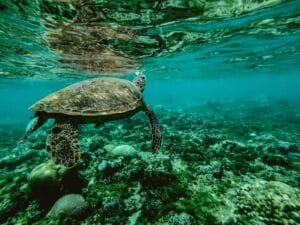Ocelots (Leopardus pardalis) are small- to medium-sized felines found from the south of North America down through South America, extending to islands off the coast (ISEC, 2025). Ocelots are listed as endangered in North America, with population sizes unknown across parts of their range. They are prized for their coats, which feature a unique spotted pattern, and are shy around humans (San Diego Zoo Animals and Plants, 2024). Despite this, Ocelots can be very aggressive, particularly when they feel threatened or their young are in danger. Ocelot conservation must be considered a research priority to ensure the survival of the species (Martinez et al., 2024).

Source: Unsplash
What Makes the Ocelot Elusive?
Ocelots are considered elusive, or difficult to locate, based on their lifecycle factors and natural behaviour (Benck Pasa et al., 2021). These factors include their natural camouflage, their preference for times of low light and their predisposition for denser vegetation. Their solitary nature aids their elusiveness and aids in predator avoidance, but also hinders conservation efforts (Puerto Maldonas Tours, 2025).
Ocelots have a spotted coat that allows them to blend in with their surroundings, particularly with the branches on which they are commonly found, making them hard to find in dense foliage, particularly when still. As they can reach a maximum height of only 40-50cm, their small stature also lends to this. Prey often don’t realise Ocelots are coming until too late. The common prey of Ocelots are rabbits, rodents, lizards, large insects, and frogs (IUCN/SSC Cat Specialist Group, 2024).

Source: Unsplash, 2019
Nocturnal animals are naturally harder to locate owing to low lighting, and have evolved to cope with times of no light through improved eyesight (Will Country, 2023). The perks of being nocturnal include less competition for resources, such as food, water, and shelter. Being nocturnal also improves temperature regulation in warmer climates and reduces energy expenditure.
Ocelots also prefer dense thickets across a range of habitats. This dense vegetation provides them protection from predators, such as pigs and wild dogs, as well as humans, while creating a safe space to nest and raise their young. This vegetation also supplies food, either as prey or vegetation, supporting crucial ecosystem functions, and offers protection from inclement weather (NSW Government, n.d.).
Where Ocelots Live: From Rainforests to Shrublands
Ocelots are found in all countries of Central and South America, up to the southern regions of North America. In North America, particularly in the United States of America, they are critically endangered. Only two known populations exist in Texas (The Nature Conservancy, 2025). These two populations are estimated to contain fewer than 100 individuals. Ocelot populations in Mexico are currently data deficient, but are thought to also be very low (San Diego Zoo Wildlife Alliance, 2024). Estimates suggest there are between 1 and 94 individuals per 100km2 across Mexico, with more dense populations found to the south (Sternberg et al., 2023).
Ocelots live in a wide range of habitats, from mangroves and forests to dry scrubland. It is thought they will live anywhere there is a high amount of cover. This includes areas with a dense understory, closed canopy, and a plethora of trees for them to climb. They also require a plentiful supply of prey and water, often supplied by denser vegetation. They have been seen on the outskirts of towns but are more likely found in thick forests (Benck Pasa et al., 2021).
Understanding Ocelot Behaviour and Hunting Patterns
The evolution of a nocturnal lifestyle has led these cats to become elusive hunters. While they are considered nocturnal, their activity peaks at dusk and dawn, setting them in the specialised category of crepuscular (Lombardi et al., 2023). They are silent and deadly, operating mainly at night, although they have also been seen on cloudy days. Hunting and travelling habits vary with moonlight levels and from country to country in South America (San Diego Zoo Wildlife Alliance, 2024). This variation in hunting can be attributed to the primary prey species of particular populations, dependent on densities and availability (Porfirio et al., 2016).
Ocelots are not like domestic cats; they are wild and can be aggressive. They have not been domesticated and view humans as a threat, potentially inflicting pain on any human attempting to approach (Lombari et al., 2023). They will stay away from human settlements, instead, travelling around towns and viallges etc. where possible. While some Ocelots have been seen in the same spot for a period of time, others have been tracked moving for more than 12 hours without rest (San Diego Zoo Wildlife Alliance, 2024). Females with young will increase hunting activity to up to 23 hours per day in order to provide them with sufficient food.
ocelot diet
Ocelots are not picky about their diet, mainly eating rodents, but also rabbits, fish, lizards, bats, frogs, and birds. While they are not picky about the meal, they will take time to remove the fur, feathers, or scales of their meal before consumption (Live Science, 2016). They are even known to store food for later, coming back when next hungry to finish the meal, ensuring that nothing is wasted. This is an example of Strong Sustainability in the animal kingdom. This ensures natural resources are used sustainably to provide for the next generation. Strong Sustainability is a Foundational Focus Factor (FFF), part of the THRIVE Framework. Twelve FFFs provide insights into the world’s issues and offer ways forward.
Threats to the Ocelot: Habitat Loss and Fragmentation
Ocelots face threats on many fronts. Population declines occurred in the 1980s, primarily owing to hunting for their fur, but also because of land use changes resulting in reduced habitat availability and habitat loss. Particularly, the populations in the northern part of the range face more threats than those in the south and are of particular concern for extinction, mainly owing to habitat loss. This reduced habitat availability has led to increased predation by invasive predators such as pigs and wild dogs. Their natural predators include cougars, coyotes, and alligators, while Ocelot kittens can be picked up by birds of prey. Threats are varied and mainly human-driven, including:
- Habitat Loss
- Trafficking/Hunting
- Climate Change
- Invasive/Introduced Species

Source: The Nature Conservation, 2025
Habitat Loss
Habitat loss is a significant issue for these cats. As they are generally solitary animals, they require space to themselves, known as a home range, ranging from 2 to 39km2 (Goulart et al., 2009). Unfortunately, this space is increasingly being taken for development, increasing fights over territory, reducing food and shelter availability, and reducing population numbers. The constant development of new roads through habitats causes fragmentation and increases the likelihood of animals being struck by cars.
Hunting/Trafficking
Ocelot fur was highly sought after in the 1960s, with almost 350,000 furs imported to the USA alone. However, since this time, the practice has diminished to the point that it is no longer considered a major threat (Mongabay, 2016). Ocelots are still trafficked, particularly from Peru and surrounding countries, to be sold as pets or for parts on the black market. However, only one in ten of these animals actually survives to be sold at these markets, with horrendous conditions and transportation methods resulting in death for the other nine. Ocelots can sell for $25 – $5000 at the local markets in the local currency (Kelly, 2018).
Climate Change
Climate change is a significant issue across the globe. Nearly every animal on Earth feels the effects of climate change. Climate change will negatively impact animals through higher temperatures and greater strain on natural resources. This includes reduced availability of prey, fewer trees, and less closed canopy areas.

Source: Unsplash
Invasive/Introduced Species
Invasive species, including feral pigs and wild dogs, are a significant threat. Ocelots have no natural defence against these animals and cannot properly defend themselves or their young. These animals take over these new habitats, wreaking havoc and altering the biodiversity of the area.
Conservation in Action: Protecting Ocelots in the Wild
The best way to conserve species is to increase awareness of their threats. This means focused public awareness campaigns. There needs to be greater focus on environmentally-based developments that prevent fragmentation and deforestation as much as possible, while also promoting the creation of wildlife corridors to allow safe passage of wildlife across ecological barriers. These barriers are any anthropogenic creation that impacts movement, such as roads, fences, and concrete barriers. Improving the habitat can also be beneficial by reducing deforestation and maintaining forests. Context-Based Metrics allow for reference to biodiversity standards such as the percentage of remaining habitat, species richness, and species abundance. Together, these metrics can provide information on the impact of species loss or targeted advice for their recovery.
Why Ocelots Matter for Ecosystem Health
Ocelots play a vital role in the food web dynamics of their environment. They are important for regulating the population of many species on which they commonly prey, including rodents, while serving as a food source for larger animals such as coyotes. These interactions regulate the health of the environment and promote healthy forest regeneration. Given their role in population regulation, some areas also consider them as keystone species, making them an invaluable part of the ecosystem, crucial to conservation efforts. Their presence or absence can also indicate the health of the ecosystem in a term regarded as indicator species.
Conclusion and Call to Action (CTA)
Given their elusivity, ocelots are difficult to track and therefore difficult to conserve. Work is underway to reintroduce populations to known habitat regions in the southern parts of its range. However, there is little evidence of re-introduction work in the northern part of the range, where work is desperately needed. Re-introductions are occurring in Texas, across 400km2 of former habitat (Recover Texas Ocelots, 2024). This will improve the biodiversity, regulate the populations of smaller animals on which they feed and improve the health of the ecosystem.
The world must be more inclusive of wildlife and environmentally conscious. This includes having more awareness when driving on roads, to avoid hitting wildlife, therefore reducing roadkill tolls and improving population numbers.
Ocelots need humanity to fight the incursion of non-native species, particularly wild dogs and pigs, while reducing deforestation rates. As they need dense forests with closed canopies, deforestation and habitat loss are important issues.
Achieving THRIVE goals
Ocelots perform regulatory functions that align with the FFF of Strong Sustainability, ensuring healthy ecosystems and maintaining food webs. Therefore, Ocelot conservation is crucial for managing ecosystem health. Science-Based Targets provide a means of measuring the performance of recovery efforts and conservation goals. Context-Based Metrics provide targeted information and resources for the allocation of such resources. Combined, these FFFs can assist in the recovery of threatened species. Ocelot population recovery uses both of these FFFs to ensure optimal progress for recovery. For instance, Science-Based Targets are specific, measurable goals, such as restoring species populations or habitats to scientifically determined levels. Context-Based Metrics inform how these targets should be pursued, taking into account local ecological conditions and system dynamics.
A Thrivable Framework
THRIVE is a not-for-profit organisation committed to improving the future and creating a flourishing world. Visit the website to stay informed on the issues facing the world and read the whitepapers, journals, and articles on a wide range of thrivability issues. Join the monthly webinar to learn from global experts about sustainable development and work towards thrivability. Subscribe to the THRIVE newsletter to keep informed on the issues facing humanity, biodiversity, and more. Become a volunteer to make a difference today.




















